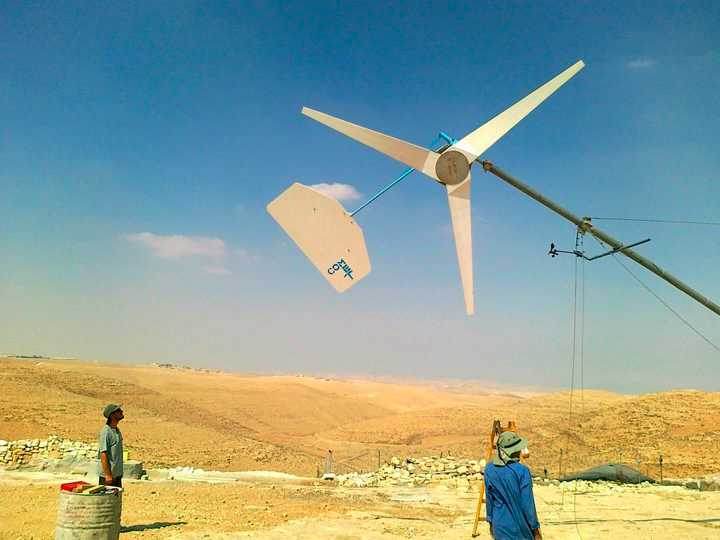I haven’t built a lot of turbines 4200 mm diameter (14 footers for the North American market). I use 16 magnets the same as the 3600 (12 foot) turbines but put them on a larger disk (450 mm/18 inches) compared with 400mm/16 inches. This allows me to put in a lot more copper to compensate for the lower rpm of the larger 4200 rotor blades.
However Jay Hudnall of Tripalium and Tieole in France has told me that he uses 20 magnets on the larger rotors and gets a higher power output. With the rising price of neodymium magnets this might not be very attractive to people in low wind areas, but it does offer better efficiency and higher peak output in stronger winds.
For those who wish to charge 48 volt batteries, the 20 magnets recipe is to use 54 turns of 2 mm diameter wire in 15 coils. For grid tie, using a Windy Boy 2500 inverter use 260 turns of 0.9mm diameter wire. The 20 magnets allow you to comfortably reach a peak output of 2500 watts instead of the 1700 watts that I would normally recommend. This inverter also operates at a higher voltage (up to 600 volts) whereas the 1700 only goes up to 400V DC.
Higher voltage and higher peak power will not win you much extra in the low winds when power is scarce, or the medium winds where most of the energy comes, from but it does improve the efficiency and productivity in higher winds for those blessed with really good sites.
Comet ME in the middle east are using these 20 magnet rotors in their latest project at Tubah.



All of the projects in my recipe book (metric) use 46 x 30 x 10 mm magnets. The Inches Recipe book uses 2x1x1/2″ magnets. To be honest you can substitute the one for the other and it makes little difference. You can fine-tune the performance by adjusting the air gap to make it run faster if necessary.
Hello Hugh.
I bought your 2014 metric edition, and I am going to use the 2x1x1/2″ magnets, as I could not find the magnets in metric sizes.
Should I make any adjustments to the magnet rotor moulds?
Thanks.
hi
You will obviously need to adapt the magnet rotor design to the slightly different magnet shape. Also you could wind your coils with smaller central holes if you want (25 mm wide holes). its a bit messy using the wrong magnets because it is hard to predict where the detail of the design will not fit nicely. also the grade of the magnets is important and if you are using grade 40 or lower you might do well to put more turns on the coils as well as using 25 mm width spacer.
I suppose I’d need full details of all what you are doing in order to help properly. Try to get the centres of the magnets to track the centres of the coils.
have fun
Hugh
Thank you for your prompt response Hugh.
I’m building the 4200 version of your book.
Since I have not attended one of your courses, and it is my first wind turbine, I think it is best to search harder for the right magnet sizes.
Thanks again.
Hi
The size of the magnets?
thanks.
The 54 turns of wire is suitable when you have 20 magnets. The voltage depends on
the number of turns per coil
the number of coils (5 in this case instead of 4)
the number f magnets (20 in this case instead of 16)
and the speed.
If you use 4 coils per phase, and 16 magnets, then I recommend using 90 turns (or at least more than 80 turns) instead of 54.
So the answer is ‘no’.
thanks a ton.
This should be applicable for 17″ dia, 16 magnets, 54 turns 2mm or 12Awg magnet wires? will it yield 48V?
Hi Sanjeev,
Yes 20 magnets will fit on an 18 inch rotor. In the metric version they used 54 turns per coil and five coils per phase to charge a 48 volt battery. The extra magnets allow you to get about 20% high power output (wind permitting).
I am just now looking at the inches version with AWG wire. It’s often a hassle designing with AWG sizes, because they are so far apart. I tend to go for a low cut in speed, thinking that you can always increase the gap if it stalls. In this case I would suggest 64 turns of #13 AWG wire in each coil.
20 magnets on 18 inch dia? 54 turns for 48V? 2 x 54 turns?